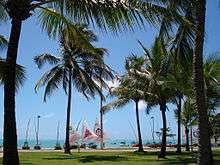Tropics
The tropics are the region of the Earth surrounding the Equator. They are delimited in latitude by the Tropic of Cancer in the Northern Hemisphere at 23°26′11.8″ (or 23.43661°) N and the Tropic of Capricorn in the Southern Hemisphere at 23°26′11.8″ (or 23.43661°) S; these latitudes correspond to the axial tilt of the Earth. The tropics are also referred to as the tropical zone and the torrid zone (see geographical zone). The tropics include all the areas on the Earth where the Sun contacts a point directly overhead at least once during the solar year (which is a subsolar point) - thus the latitude of the tropics is roughly equal to the angle of the Earth's axial tilt.
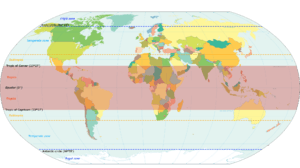
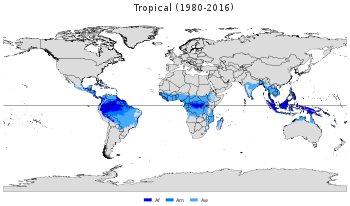
In terms of climate, the tropics receive sunlight that is more direct than the rest of Earth and are generally hotter and wetter. The word "tropical" sometimes refers to this sort of climate rather than to the geographical zone. The tropical zone includes deserts and snow-capped mountains, which are not tropical in the climatic sense. The tropics are distinguished from the other climatic and biomatic regions of Earth, which are the middle latitudes and the polar regions on either side of the equatorial zone.
The tropics constitute 40% of the Earth's surface area[1] and contain 36% of the Earth's landmass.[2] As of 2014, the region was home to 40% of the world's population, and this figure was then projected to reach 50% by 2050.[3]
Etymology
The word "tropic" comes from Ancient Greek τροπή (tropē), meaning "to turn" or "change direction", as the Sun appears to cease its southerly course when it reaches this latitude and begins moving back to the north.
Seasons and climate
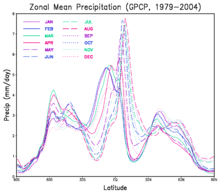
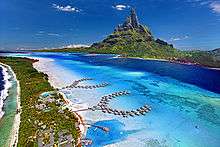
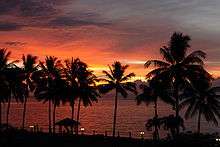
"Tropical" is sometimes used in a general sense for a tropical climate to mean warm to hot and moist year-round, often with the sense of lush vegetation.
Many tropical areas have a dry and wet season. The wet season, rainy season or green season is the time of year, ranging from one or more months, when most of the average annual rainfall in a region falls.[4] Areas with wet seasons are disseminated across portions of the tropics and subtropics.[5] Under the Köppen climate classification, for tropical climates, a wet-season month is defined as a month where average precipitation is 60 millimetres (2.4 in) or more.[6] Tropical rainforests technically do not have dry or wet seasons, since their rainfall is equally distributed through the year.[7] Some areas with pronounced rainy seasons see a break in rainfall during mid-season when the intertropical convergence zone or monsoon trough moves poleward of their location during the middle of the warm season;[8] typical vegetation in these areas ranges from moist seasonal tropical forests to savannahs.
When the wet season occurs during the warm season, or summer, precipitation falls mainly during the late afternoon and early evening hours. The wet season is a time when air quality improves, freshwater quality improves and vegetation grows significantly, leading to crop yields late in the season. Floods cause rivers to overflow their banks, and some animals to retreat to higher ground. Soil nutrients diminish and erosion increases. The incidence of malaria increases in areas where the rainy season coincides with high temperatures. Animals have adaptation and survival strategies for the wetter regime. The previous dry season leads to food shortages into the wet season, as the crops have yet to mature.
However, regions within the tropics may well not have a tropical climate. Under the Köppen climate classification, much of the area within the geographical tropics is classed not as "tropical" but as "dry" (arid or semi-arid), including the Sahara Desert, the Atacama Desert and Australian Outback. Also, there are alpine tundra and snow-capped peaks, including Mauna Kea, Mount Kilimanjaro, and the Andes as far south as the northernmost parts of Chile and Perú.
Ecosystems
Tropical plants and animals are those species native to the tropics. Tropical ecosystems may consist of tropical rainforests, seasonal tropical forests, dry (often deciduous) forests, spiny forests, desert and other habitat types. There are often significant areas of biodiversity, and species endemism present, particularly in rainforests and seasonal forests. Some examples of important biodiversity and high endemism ecosystems are El Yunque National Forest in Puerto Rico, Costa Rican and Nicaraguan rainforests, Amazon Rainforest territories of several South American countries, Madagascar dry deciduous forests, the Waterberg Biosphere of South Africa, and eastern Madagascar rainforests. Often the soils of tropical forests are low in nutrient content, making them quite vulnerable to slash-and-burn deforestation techniques, which are sometimes an element of shifting cultivation agricultural systems.
In biogeography, the tropics are divided into Paleotropics (Africa, Asia and Australia) and Neotropics (Caribbean, Central America, and South America). Together, they are sometimes referred to as the Pantropic. The system of biogeographic realms differs somewhat; the Neotropical realm includes both the Neotropics and temperate South America, and the Paleotropics correspond to the Afrotropical, Indomalayan, Oceanian, and tropical Australasian realms.
Tropicality
Tropicality refers to the image that people outside the tropics have of the region, ranging from critical to verging on fetishism. The idea of tropicality gained renewed interest in geographical discourse when French geographer Pierre Gourou published Les Pays Tropicaux (The Tropical World in English), in the late 1940s.[9]
Tropicality encompassed two images. One, is that the tropics represent a 'Garden of Eden', a heaven on Earth, a land of rich biodiversity - aka a tropical paradise.[10] The alternative is that the tropics consist of wild, unconquerable nature. The latter view was often discussed in old Western literature more so than the first.[10] Evidence suggests over time that the view of the tropics as such in popular literature has been supplanted by more well-rounded and sophisticated interpretations.[11]
Western scholars tried to theorize reasons about why tropical areas were relatively more inhospitable to human civilisations then those existing in colder regions of the Northern Hemisphere. A popular explanation focused on the differences in climate. Tropical jungles and rainforests have much more humid and hotter weather than colder and drier temperaments of the Northern Hemisphere. This theme led to some scholars to suggest that humid hot climates correlate to human populations lacking control over nature e.g. ' the wild Amazonian rainforests'.[12]
See also
References
- "How much land is in the tropics?". God Plays Dice. 2007-12-04. Retrieved 2017-06-26.
- "tropics". National Geographic Encyclopedia. National Geographic Society. Retrieved 2017-06-26.
- "Expanding tropics will play greater global role, report predicts". Science Magazine. 29 June 2014.
- Glossary of Meteorology (2009). Rainy season. Archived 2009-02-15 at the Wayback Machine American Meteorological Society. Retrieved on 2008-12-27.
- Michael Pidwirny (2008). CHAPTER 9: Introduction to the Biosphere. PhysicalGeography.net. Retrieved on 2008-12-27.
- "Updated world Koppen-Geiger climate classification map" (PDF).
- Elisabeth M. Benders-Hyde (2003). World Climates. Blue Planet Biomes. Retrieved on 2008-12-27.
- J . S. 0guntoyinbo and F. 0. Akintola (1983). Rainstorm characteristics affecting water availability for agriculture. Archived 2009-02-05 at the Wayback Machine IAHS Publication Number 140. Retrieved on 2008-12-27
- Arnold, David. "Illusory Riches: Representations of the Tropical World, 1840-1950", p. 6. Journal of Tropical Geography
- Arnold, David. "Illusory Riches: Representations of the Tropical World, 1840-1950", p. 7. Journal of Tropical Geography
- Menadue, Christopher B. (2017-05-30). "Trysts Tropiques: The Torrid Jungles of Science Fiction" (PDF). ETropic: Electronic Journal of Studies in the Tropics. 16 (1). doi:10.25120/etropic.16.1.2017.3570. ISSN 1448-2940.
- Arnold, David. "Illusory Riches: Representations of the Tropical World, 1840-1950", p. 13. Journal of Tropical Geography
External links
| Wikimedia Commons has media related to Tropics. |
